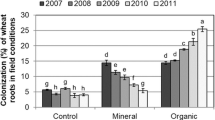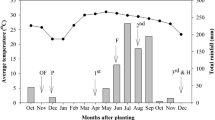Abstract
The present investigation examines whether the crop plant, increased nitrogen (N) fertilization and fungicide application influence the pattern of vesicular-arbuscular mycorrhizal fungi (VAM) populations. For this purpose, two arable field locations in Lower Saxony (Hotteln and Langreder) were chosen and the formation of mycorrhiza, spore density, number of infectious propagules (MPN) and frequency of spore types within VAM populations were investigated. The influence of crop plants was examined over two cultivation periods (1986/1987 and 1987/1988) in Hotteln, comparing winter wheat, winter barley and sugar beet. The effects of increased N fertilization and fungicide application were investigated on winter wheat in Langreder in the cultivation period 1988 only. Both the frequency of mycorrhizal infection and the spore dynamics in soil differed with the crops grown. Spore density and MPN increased until harvesting when host plants (winter wheat, winter barley) were cultivated, whereas both diminished with a non-host plant (sugar beet). Different spore types increased or decreased, according to the plant species grown, but the predominating types of the location remained constant. Increased N fertilization caused marginal inhibition of mycorrhizal infection and sporulation on winter wheat, whereas both leaf and base application of fungicides resulted in minor increases in mycorrhizal colonization of roots and sporulation in soil. Both increased N fertilization and fungicide application distinctly decreased the sporulation of one type in May, but the characteristic compositions of the VAM populations remained unchanged.
Similar content being viewed by others
References
Alexander M (1965) Most probable number method for microbial populations. In: Black CA (ed) Methods of soil analysis, part 2: Chemical and microbial properties. American Society of Agronomy, Madison, Wis, pp 1467–1472
Baltruschat H, Dehne H-W (1982) Zum Auftreten der endotrophen Mykorrhizen in verschiedenen Getreidefruchtfolgen und Düngesystemen. Meded Rijksfac Landbouwwet Gent 47:831–839
Bowen GD (1985) Physiological factors in infection and spread of VAM. In: Molina R (ed) Proceedings of the 6th North American Conference on Mycorrhizae. Forest Research Laboratory, Corvallis, pp 181–184
Cochran WG (1950) Estimation of bacterial densities by means of the “most probable number” method. Biometrics 6:105–116
Daniels Hetrick BA, Bloom MJ (1986) The influence of host plant on production and colonization ability of vesicular-arbuscular mycorrhizal spores. Mycologia 78:32–36
Dehne H-W (1985) Influence of pesticides on the development of vesicular arbuscular mycorrhizae. (Les colloques de l'INRA, no 31) INRA, Versailles
Dehne H-W (1986) Untersuchungen zum Einfuß von Pflanzenbehandlungsmitteln auf das Auftreten der VA-Mykorrhiza. Meded Fac Landbouwwet Rijksuniv Gent 51:465–475
Dodd JC, Jeffries P (1989) Effect of fungicides on three vesicular-arbuscular mycorrhizal fungi associated with winter wheat (Triticum aestivum L.). Biol Fertil Soils 7:120–128
Fang Y-C, McGraw A-C, Hakam M, Hendrix JM (1983) A procedure for isolating single-spore cultures of certain endomycorrhizal fungi. New Phytol 93:107–114
Fisher RA, Yates F (1974) Statistical tables for biological, agricultural and medical research. Oliver and Boyd, Edinburgh (Table VIII 2:p66)
Förster H, Buchenauer H, Grossmann F (1980) Nebenwirkungen der systemischen Fungizide Triadimenol und Triadimefon auf Gerstenpflanzen. II. Cytokininartige Effekte. Z Pflanzenkr Pflanzenschutz 87:640–653
Gerdemann JW, Nicolson TH (1963) Spores of mycorrhizal Endogone extracted from soil by wet-sieving and decanting. Trans Br Mycol Soc 46:235–244
Gerlach D (1969) Botanische Mikrotechnik. Thieme, Stuttgart
Gnekow A (1988) Die Rolle von VA-Mykorrhiza bei der Phosphaternährung von Kulturpflanzen in Abhängigkeit von Phosphatdüngung und Bewirtschaftungsweise. Dissertation, Universität Hohenheim
Harinikumar KM, Bagyaraj DJ (1988) Effect of crop rotation on native vesicular-arbuscular mycorrhizal propagules in soil. Plant Soil 110:77–80
Harinikumar KM, Bagyaraj DJ (1989) Effect of cropping sequence, fertilizers and farmyard manure on vesicular-arbuscular mycorrhizal fungi in different crops over three consecutive seasons. Biol Fertil Soils 7:173–175
Hayman DS (1970) Endogone spore numbers in soil and vesicular-arbuscular mycorrhizae in wheat as influenced by season and soil treatment. Trans Br Mycol Soc 54:53–63
Hayman DS (1974) The occurrence of mycorrhiza in crops as affected by soil fertility. In: Sanders FE, Mosse B, Tinker PB (eds) Endomycorrhizas. Academic Press, London, pp 495–509
Hayman DS, Tavares M (1985) Plant growth responses to vesicular-arbuscular mycorrhiza. XV. Influence of soil pH on the symbiotic efficiency of different endophytes. New Phytol 100:367–377
Jensen A, Jacobsen A (1980) The occurrence of vesicular-arbuscular mycorrhiza in barley and wheat grown in some Danish soils with different fertilizer treatments. Plant Soil 55:403–414
Koske RE (1982) Evidence for a volatile attractant from plant roots affecting germ tubes of a VA mycorrhizal fungus. Trans Br Mycol Soc 79:305–310
Kruckelmann HW (1975) Effects of fertilizers, soils, soil tillage, and plant species on the frequency of Endogone chlamydospores and mycorrhizal infection in arable soils. In: Sanders FE, Mosse B, Tinker PB (eds) Endomycorrhizas. Academic Press, London, pp 511–525
Land S (1990) Auftreten und Charakterisierung der vesikulär-arbuskulären (VA) Mykorrhiza in intensiv genutzten Ackerböden. Dissertation, Universität Hannover
Land S, Schönbeck F (1991) Influence of different soil types on abundance and seasonal dynamics of vesicular arbuscular mycorrhizal fungi in arable soils of North Germany. Mycorrhiza 1:39–44
Menge JA (1982) Effect of soil fumigants and fungicides on vesicular-arbuscular fungi. Phytopathology 72:1125–1132
Nemec S (1980) Effects of 11 fungicides on endomycorrhizal development in sour orange. Can J Bot 58:522–526
Ocampo JA, Hayman DS (1980) Effects of pesticides on mycorrhiza in field-grown barley, maize and potatoes. Trans Br Mycol Soc 74:413–416
Peuss H (1958) Untersuchungen zur Ökologie und Bedeutung der Tabakmykorrhiza. Arch Mikrobiol 29:112–142
Sachs L (1974) Angewandte Statistik, 4th edn. Springer, Berlin Heidelberg New York
Schenck NC, Kinloch RA (1980) Incidence of mycorrhizal fungi on six field crops in monoculture on newly cleared woodland site. Mycologia 72:445–456
Sieverding E (1981) Influence of soil water regimes on VA-mycorrhiza. I. Effect on plant growth, water utilization and development of mycorrhiza. J Agron Crop Sci 150:400–411
Sieverding E, Leihner DE (1984) Influence of crop rotation and intercropping of cassava on VA-mycorrhizal symbiosis of cassava. Plant Soil 80:143–146
Simpson D, Daft MJ (1990) Spore production and mycorrhizal development in various tropical crop hosts infected with Glomus darum. Plant Soil 121:121–178
Strubble JE, Skipper HD (1988) Vesicular-arbuscular mycorrhizal fungal spore production as influenced by plant species. Plant Soil 109:277–280
Tommerup IC (1984) Temperature relations of spore germination and hyphal growth of vesicular-arbuscular mycorrhizal fungi in soil. Trans Br Mycol Soc 81:381–387
Tommerup IC, Briggs GG (1981) Influence of agricultural chemicals on germination of vesicular-arbuscular endophyte spores. Trans Br Mycol Soc 76:326–328
Winter AG (1951) Untersuchungen über die Verbreitung und Bedeutung der Mykorrhiza bei kultivierten Gramineen und einigen anderen landwirtschaftlichen Nutzpflanzen. Phytopathol Z 17:421–432
Zadoks JC, Chang TT, Konzak CF (1974) A decimal code for the growth stages of cereals. Weed Res 14:415–421
Author information
Authors and Affiliations
Rights and permissions
About this article
Cite this article
Land, S., von Alten, H. & Schönbeck, F. The influence of host plant, nitrogen fertilization and fungicide application on the abundance and seasonal dynamics of vesicular-arbuscular mycorrhizal fungi in arable soils of northern Germany. Mycorrhiza 2, 157–166 (1993). https://doi.org/10.1007/BF00210585
Issue Date:
DOI: https://doi.org/10.1007/BF00210585




